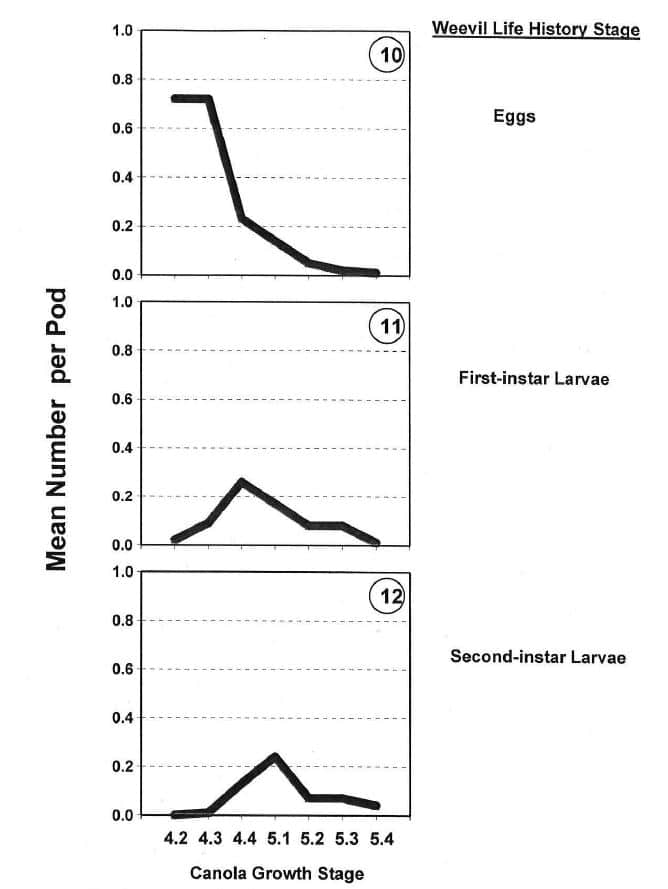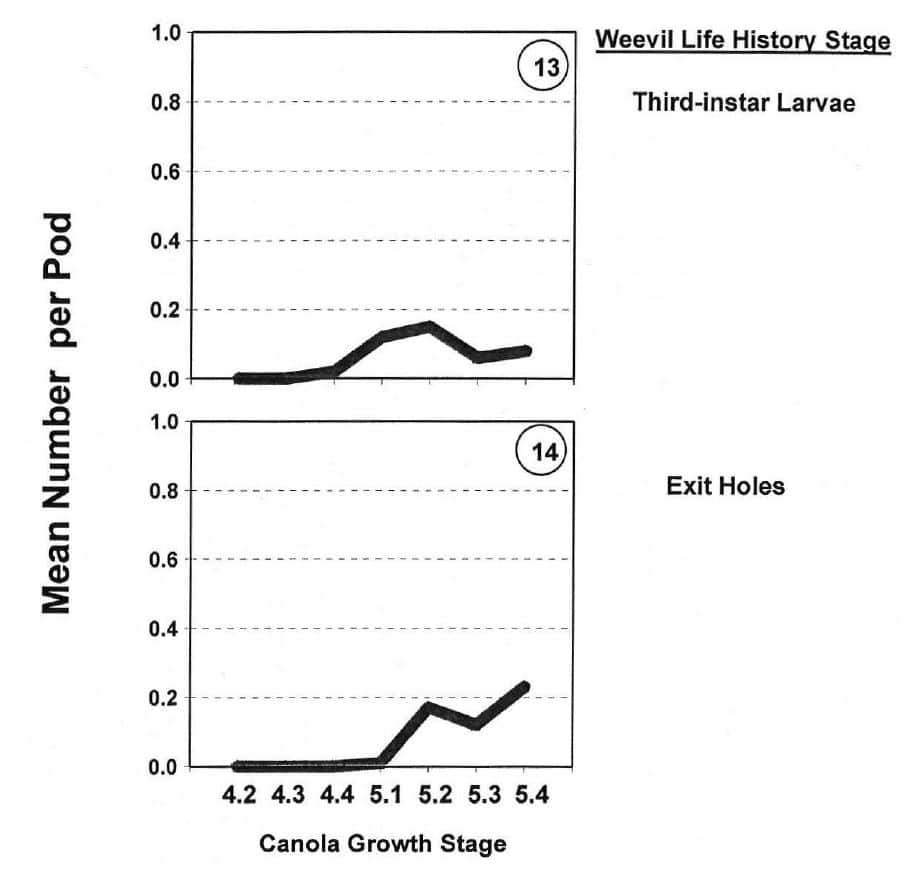Key Result
Cabbage seedpod weevil adults invade canola crops in spring and crops become particularly susceptible to infestation when they reach the bud stage, so canola growers should vigilantly monitor their crops at this time, and collect samples with sweep nets to see if populations are near economic thresholds.
Project Summary
The cabbage seedpod weevil, Ceutorhynchus obstrictus (Marsham), was first observed infesting canola fields in Alberta only in 1995, but already it has dispersed extensively throughout southern and central Alberta. In 1999 and 2000, outbreaks of the cabbage seedpod weevil occurred in Alberta, with population densities as high as 15 to 80 adults per sweep net sample. These infestation levels were well in excess of the economic threshold of 2 to 3 adults per sweep net sample that is used in the U.S.A., and the threshold of 3 to 4 adults per sweep that has been used in Alberta.
Most research results reported here were obtained during the 1998 and 1999 field seasons because data from several studies conducted near Lethbridge in 2000 were compromised by frost and severe drought. In the 2000 studies, it was often difficult to separate, with confidence, effects of weevil feeding versus effects of the drought.
Adult weevils emerged from their overwintering sites over an extended period in early spring. Mating occurred for several weeks, and in spring adults initially occurred in high densities in volunteer canola and in cruciferous weeds. Wild mustard was a true host of cabbage seedpod weevil because larval development occurred within pods of this plant. Before canola crops were susceptible to invasion of the cabbage seedpod weevil in the bud to flowering stages, adult weevils fed upon flixweed, stinkweed, and hoary cress but no larval development occurred in pods of these species.


Although greater numbers of weevils tended to occur in early-seeded plots of canola than in plots seeded later, these differences were not significant statistically. Altering seeding date in spring plantings does not appear to hold great promise, therefore, as a cultural control strategy for this pest. However, the Brassica napus cultivar, Option 500, was found to be significantly less susceptible to attack by the weevil than the Hylite 201 and Hyola 401 cultivars. Canola growers should therefore be encouraged to plant less susceptible varieties like Option 500.
Species of Brassicaceae differed in their susceptibilities to infestation by cabbage seedpod weevil. For the species and cultivars we evaluated under field conditions, Brassica napus cv. Q2 was most susceptible, Brassica juncea cvs. Forge and Commercial Brown were intermediate in susceptibilities, and Sinapis alba cv. AC Pennant was resistant to infestation. Sinapis alba can therefore serve as a genetic source of resistance to cabbage seedpod weevil for use in germplasm development programs to eventually develop canola resistant to attack by this pest.
In 1998 and 1999, no evidence of parasitism was observed in either larvae or adults of Alberta populations of C. obstrictus. In 2000, however, parasitoids infesting cabbage seedpod weevil adults were found at three sites near Lethbridge. At one site, hundreds of weevils were collected and placed into screened cages to capture emerged parasitoid adults; parasitism levels of approximately 18% were then recorded from this site. The identity of this parasitoid has not yet been verified, but it is a member of the Hymenoptera family Braconidae, subfamily Euphorinae. It is probable that this is the European parasitoid Microctonus melanopus Ruthe, a species previously found to be significant in reducing survival of adult weevils in Idaho and Washington.
Pan trap sampling was effective for monitoring adult weevil populations in the seedling and rosette stages of canola development, but as crop development proceeded, sweep net sampling was a more effective monitoring strategy. Because adults of C. obstrictus are most attracted to canola in the bud to flowering stages, it is recommended that canola growers use sweep net sampling to monitor cabbage seedpod weevil populations in their crops.
The distribution and abundance of the cabbage seedpod weevil increased extensively in 1999 and 2000 relative to 1998 and 1997. In 2000, the range of the species extended as far north as Innisfail, Olds, Oyen, and Hanna, and as far east as southwestern Saskatchewan. Population densities of the cabbage seedpod weevil were much greater than those observed in previous years. Pan trap sampling was conducted in canola research plots at sites in close proximity to each other from 1998 to 2000. Mean numbers of adult weevils per pan trap sample recorded during the first week of June in each year increased 232-fold between 1998 and 2000, and 14-fold between 1999 and 2000.
Insecticides now used to control other important insect pests of canola are also effective for controlling infestations of cabbage seedpod weevil. In particular, synthetic pyrethroid products are very effective, providing rapid mortality of cabbage seedpod weevil adults. Synthetic pyrethroid insecticides are advantageous for weevil control compared with some organophosphate insecticides because they have little residual activity – an important consideration because it is necessary to spray crops in flower to attain maximum weevil mortality in canola.
It is evident that further research is needed to meet the challenges posed by this serious pest of canola. Research should be undertaken to evaluate various cultural control strategies like trap cropping, fall seeding, altering seeding rates, fertility regimes, and row spacings to identify those practices most effective in increasing the competitiveness of the crop relative to the pest. Biological control of the cabbage seedpod weevil should be enhanced. In the United States and Europe, biocontrol agents cause major reductions in cabbage seedpod weevil populations, but in Alberta, only small populations of parasitoids were found.Research should be undertaken to identify and evaluate different biological control agents of cabbage seedpod weevil, to obtain any necessary regulatory approvals for their release in western Canada, and to eventually release biocontrol agents at different sites throughout western Canada. Finally, a germplasm development program should be initiated to evaluate species and cultivars of Brassicaceae to identify sources of resistance, to use biotechnological approaches to locate the genes for resistance in the genome, and to then transfer resistance genes to commercial cultivars of canola. By using such a multi-faceted approach to pest management that involves attacking cabbage seedpod weevil infestations from several different angles at the same time, it should be possible to limit crop losses from this pest and improve the profitability of canola production in western Canada.





